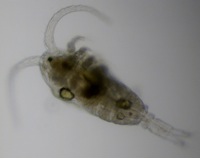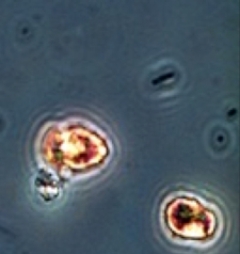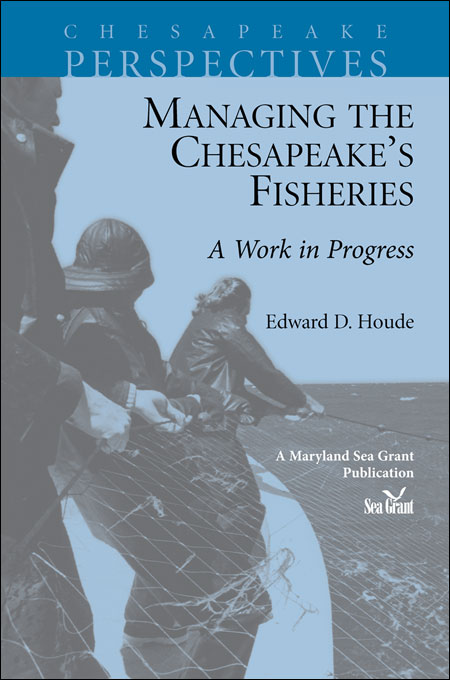Knauss legislative fellowships in Congress help build careers — and they're fun and educational. See our video and fact sheet for details.
Sampling the Bay in Winter: Investigating Cold Water Mysteries
Meet Heterocapsa rotundata, a species of phytoplankton that is about 10 micrometers in length.
While this organism might not look that impressive at first glance, to me this is the most important organism in the Chesapeake Bay and could impact striped bass abundance.
Winter is H. rotundata’s time to shine. When temperatures drop to their lowest all year, this species of phytoplankton (plankton that photosynthesize) can reach high densities, greater than 20,000 cells per milliliter. You might think that Bay plankton perform little photosynthesis during the cold, dark winter months. But the presence of dense winter phytoplankton blooms shows otherwise.
While the metabolisms of most organisms in the Bay slow down and their growth rates come almost to a standstill in winter, H. rotundata thrives under these low temperatures with little competition from other phytoplankton. However, very little is known about the frequency of their blooms, or anything surrounding the impacts of those blooms on the ecosystem in the winter, because research scientists and monitoring groups generally do little field work and data collection at this time of year.
Unlike most research scientists, Maryland winters don’t deter my desire to do field work. I am from northern Minnesota, so even the coldest, windiest, and snowiest day in Maryland is quite pleasant by my standards. Since 2011-12, I have set up weekly experiments each winter with water I took from the Choptank River near Horn Point Lab in Cambridge, Maryland. In my three years of sampling I have done the highest resolution sampling for the winter season in the Choptank River. I have shown by how much H. rotundata abundance can vary from year to year as well as within each year.
I have a real interest in the ecology of marine environments, specifically predator-prey interactions. So I set up experiments in the winters of 2011-12, 2012-13 and 2013-14 to make three main observations:
- Which predators, if any, are consuming H. rotundata?
- If there are predators grazing on H. rotundata, how do the predators impact H. rotundata abundance?
- In turn, how do H. rotundata impact predator abundance?
I have found different organisms grazing on H. rotundata. Of all these organisms, I am most interested in a copepod called Eurytemora carolleeae. A copepod is a small crustacean, around 1 millimeter in size, which is also a kind of plankton (and which you might have seen featured as the character “Sheldon J. Plankton” in “SpongeBob SquarePants.”) In fact, I found that E. carolleeae prefers to eat H. rotundata compared to all the other available prey items.
 |
 |
| Eurytemora carolleeae | Sheldon J. Plankton |
|
See the similarity? |
|
In 2012-2013 I concluded that high grazing pressure from predators kept H. rotundata abundances low. But in 2013-2014 there was less grazing pressure in the winter, which allowed the organism’s abundance to increase. This showed that grazing pressure plays a role in determining the abundance of H. rotundata.
The reverse can occur as well: the abundance of H. rotundata in winter may determine the springtime abundance of E. carolleeae. In the spring of 2014, after almost two months of the winter H. rotundata bloom, adult E. carolleeae abundance rapidly increased over a short period of time. These E. carolleeae had hatched during winter, but it took them two months to mature. The winter abundance of H. rotundata provided the maturing E. carolleeae with abundant food.
Why does any of this matter? Why should anyone care that there are winter blooms of H. rotundata and that they lead to higher abundance of E. carolleeae? The short answer: the striped bass and its food chain.
E. carolleeae is a favored food item for developing striped bass larvae when they first start to eat. The more E. carolleeae that is present when striped bass larvae hatch, the higher the survival of these larvae for that year. The species is important to the recreational and commercial fisheries in the Chesapeake Bay area, and a lot of work has been put into models that predict survival of striped bass larvae each year in order to create a sustainable fishery. But the best models can still be way off in some years. Understanding more about the winter season, H. rotundata blooms, and their effect on E. carolleeae abundance might be the key to predicting the success of striped bass in the Bay.

Credits: Photograph of H. rotundata (top and figure), The Baltic Sea Portal; photograph of E. carolleeae (above and figure), Carol Lee; photograph of striped bass larvae, David Ostrach; drawing of Sheldon J. Plankton, © Nickelodeon; figure (bottom), Nicole Millette.
See all posts to the Fellowship Experiences blog




